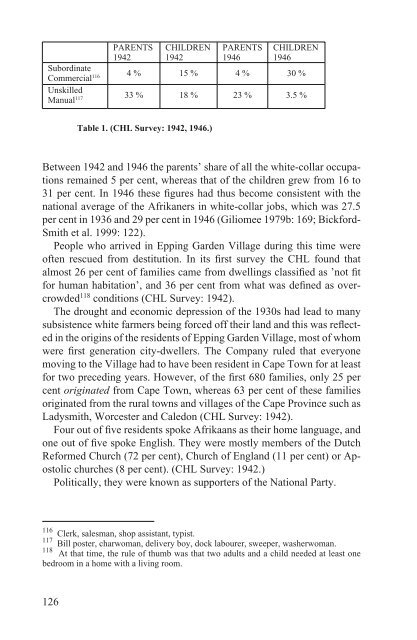The Making of a Good White - E-thesis - Helsinki.fi
The Making of a Good White - E-thesis - Helsinki.fi
The Making of a Good White - E-thesis - Helsinki.fi
Create successful ePaper yourself
Turn your PDF publications into a flip-book with our unique Google optimized e-Paper software.
PARENTS<br />
1942<br />
CHILDREN<br />
1942<br />
PARENTS<br />
1946<br />
CHILDREN<br />
1946<br />
Subordinate<br />
Commercial 116 4 % 15 % 4 % 30 %<br />
Unskilled<br />
Manual 117 33 % 18 % 23 % 3.5 %<br />
Table 1. (CHL Survey: 1942, 1946.)<br />
Between 1942 and 1946 the parents’ share <strong>of</strong> all the white-collar occupations<br />
remained 5 per cent, whereas that <strong>of</strong> the children grew from 16 to<br />
31 per cent. In 1946 these <strong>fi</strong>gures had thus become consistent with the<br />
national average <strong>of</strong> the Afrikaners in white-collar jobs, which was 27.5<br />
per cent in 1936 and 29 per cent in 1946 (Giliomee 1979b: 169; Bickford-<br />
Smith et al. 1999: 122).<br />
People who arrived in Epping Garden Village during this time were<br />
<strong>of</strong>ten rescued from destitution. In its <strong>fi</strong>rst survey the CHL found that<br />
almost 26 per cent <strong>of</strong> families came from dwellings classi<strong>fi</strong>ed as ’not <strong>fi</strong>t<br />
for human habitation’, and 36 per cent from what was de<strong>fi</strong>ned as overcrowded<br />
118 conditions (CHL Survey: 1942).<br />
<strong>The</strong> drought and economic depression <strong>of</strong> the 1930s had lead to many<br />
subsistence white farmers being forced <strong>of</strong>f their land and this was reflected<br />
in the origins <strong>of</strong> the residents <strong>of</strong> Epping Garden Village, most <strong>of</strong> whom<br />
were <strong>fi</strong>rst generation city-dwellers. <strong>The</strong> Company ruled that everyone<br />
moving to the Village had to have been resident in Cape Town for at least<br />
for two preceding years. However, <strong>of</strong> the <strong>fi</strong>rst 680 families, only 25 per<br />
cent originated from Cape Town, whereas 63 per cent <strong>of</strong> these families<br />
originated from the rural towns and villages <strong>of</strong> the Cape Province such as<br />
Ladysmith, Worcester and Caledon (CHL Survey: 1942).<br />
Four out <strong>of</strong> <strong>fi</strong>ve residents spoke Afrikaans as their home language, and<br />
one out <strong>of</strong> <strong>fi</strong>ve spoke English. <strong>The</strong>y were mostly members <strong>of</strong> the Dutch<br />
Reformed Church (72 per cent), Church <strong>of</strong> England (11 per cent) or Apostolic<br />
churches (8 per cent). (CHL Survey: 1942.)<br />
Politically, they were known as supporters <strong>of</strong> the National Party.<br />
116 Clerk, salesman, shop assistant, typist.<br />
117 Bill poster, charwoman, delivery boy, dock labourer, sweeper, washerwoman.<br />
118 At that time, the rule <strong>of</strong> thumb was that two adults and a child needed at least one<br />
bedroom in a home with a living room.<br />
126
















